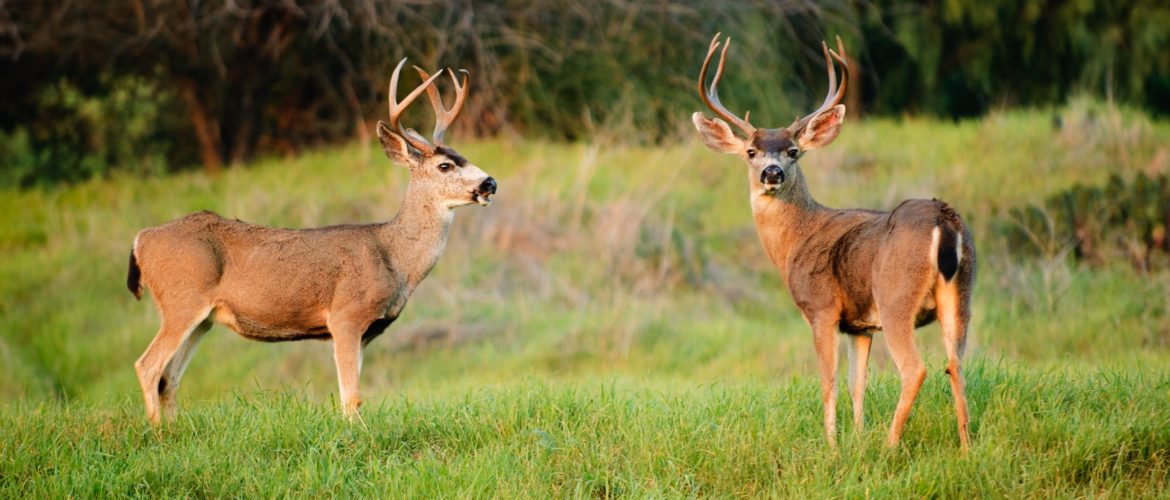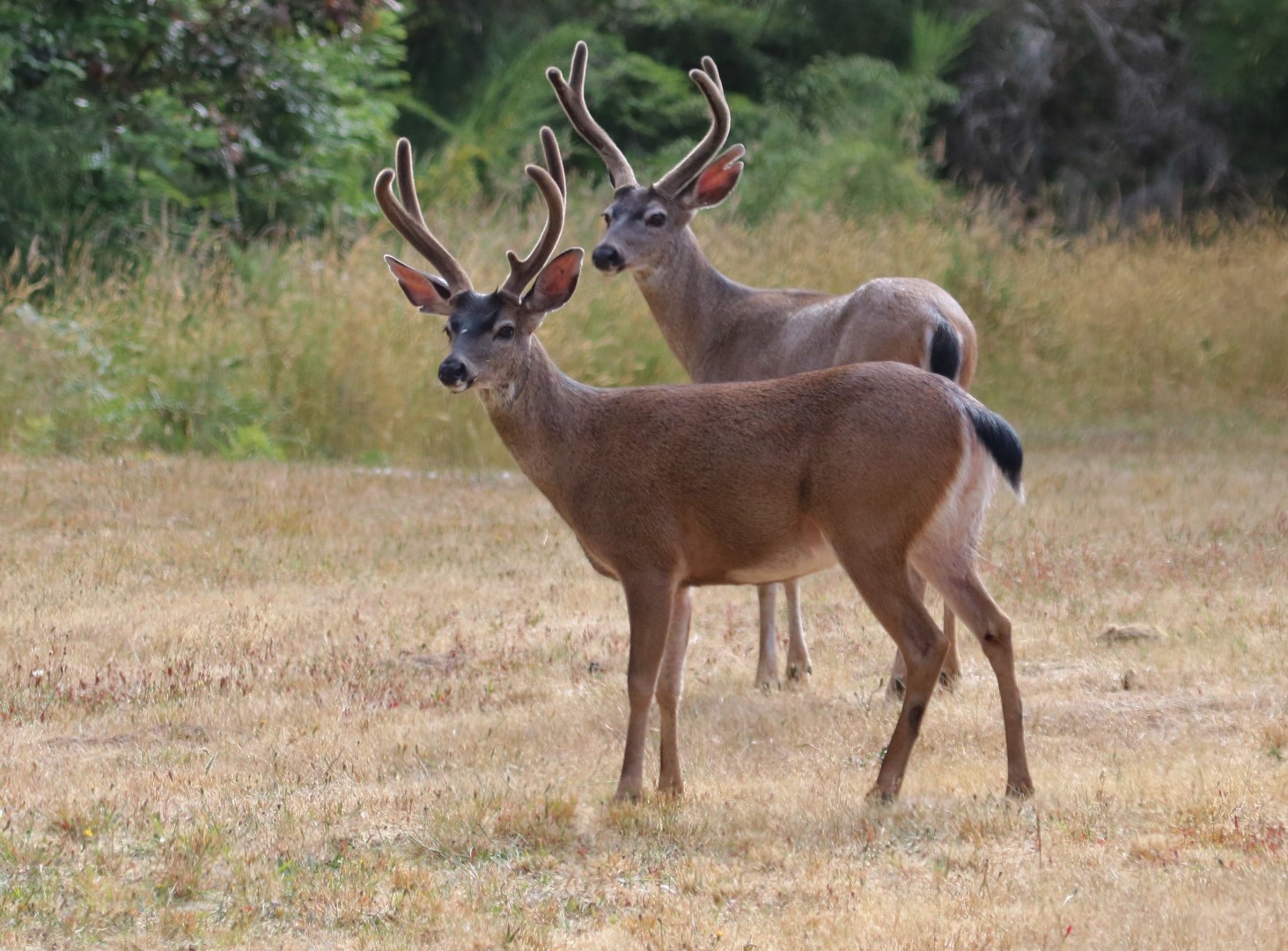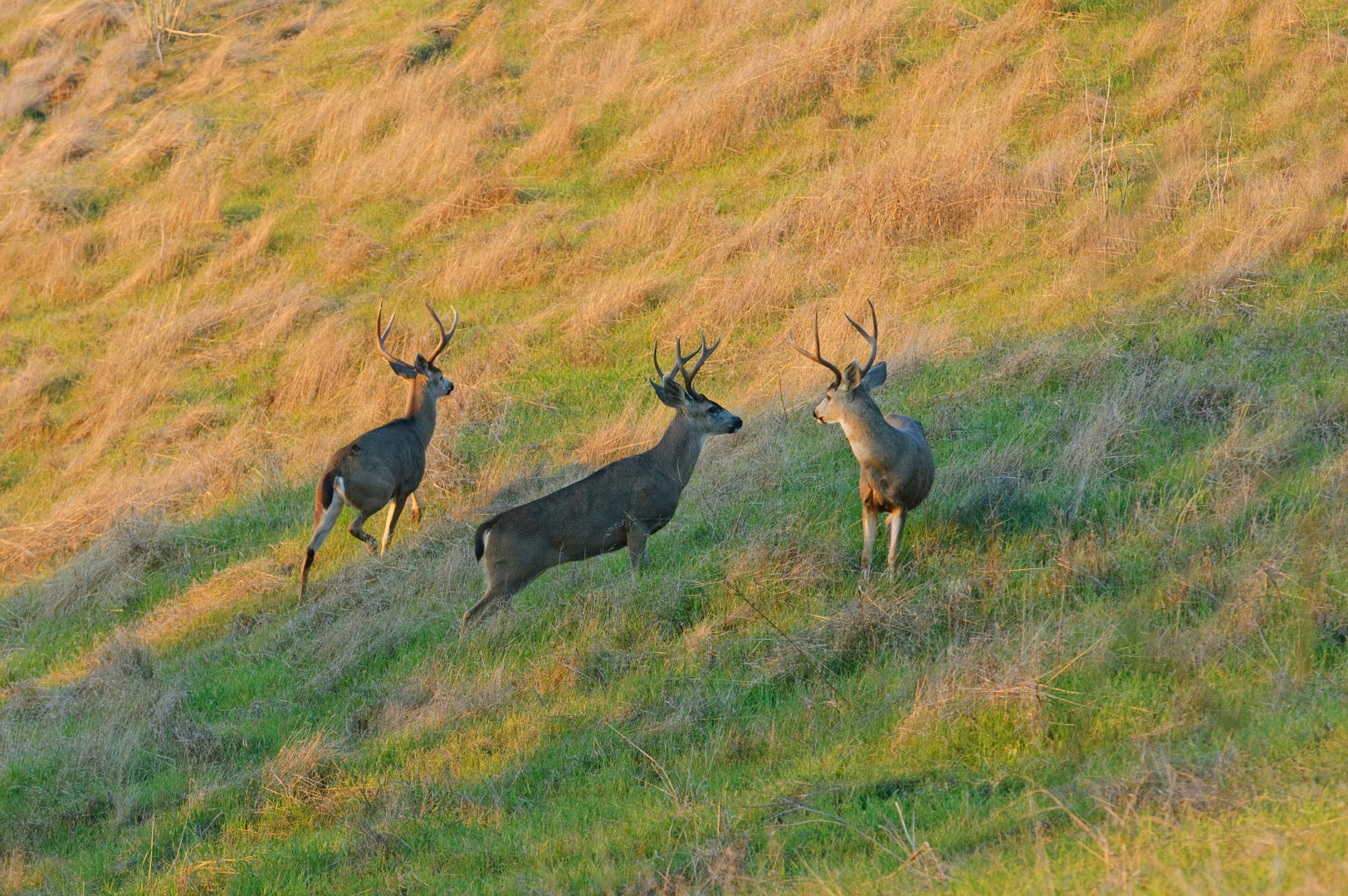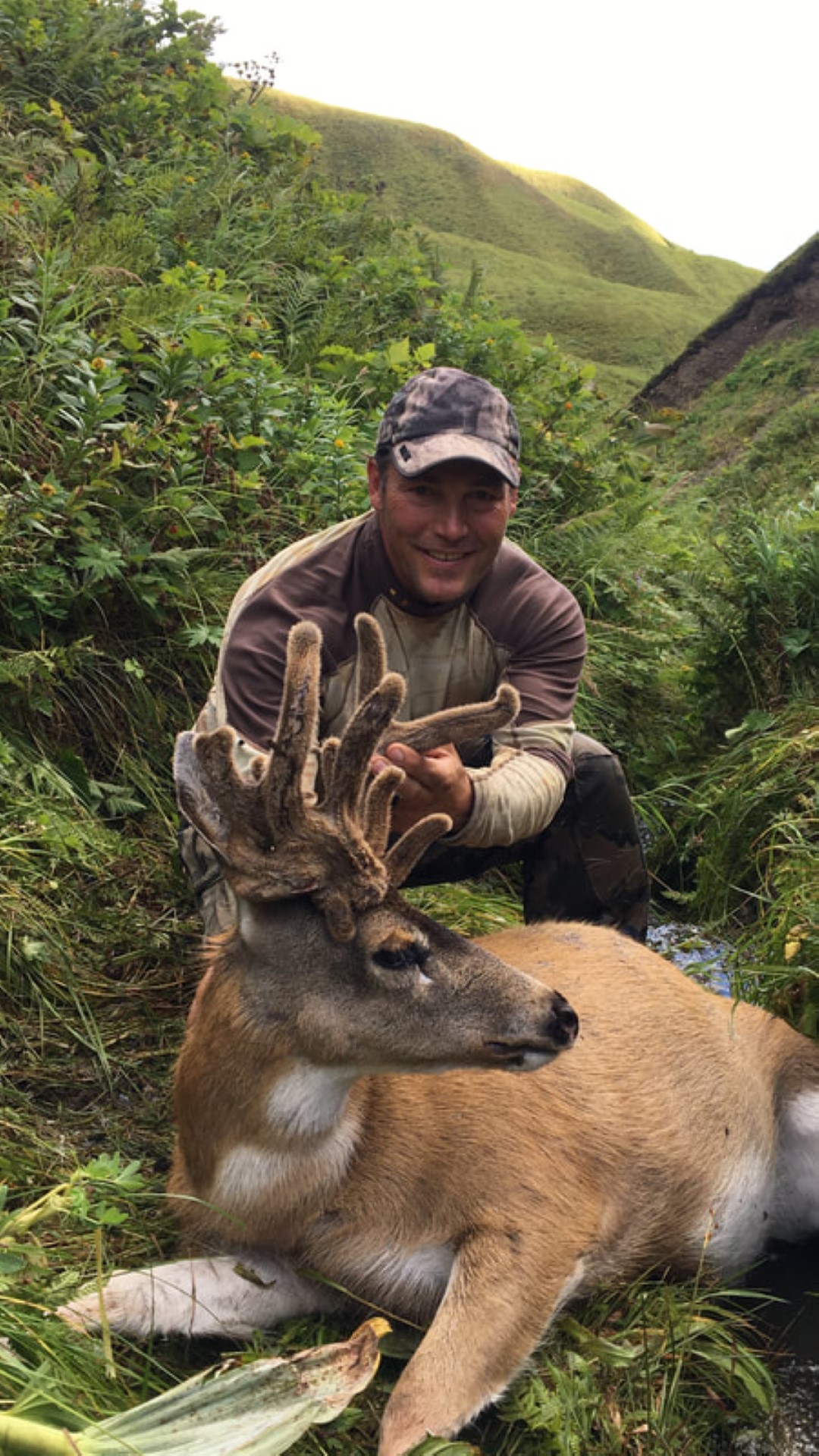$0.00
No products in the cart.

The Black-tailed, often referred to as the Black-tail deer is a smaller, darker subspecies of the Mule deer (Odocoileus hemionus). There are two forms of the Black-tail that occupy the coastal woodlands of the Pacific Northwest of North America.
Although having been referenced as a species in their own right, current data suggests that they are in fact a subspecies comprised of the Columbian Black-tailed deer (O. h. columbianus) and the Sitka Black-tailed deer (O. h. sitkensis).
Current accounts report that the Black-tail deer is split into two subspecies of the Mule deer inhabiting a large footprint of the Coastal region of North America. Although, generally recognised as a subspecies, and in some literature as their own species. Sanchez Rojas, G. & Gallina Tessaro, S. (2008) makes reference to the term conspecific, meaning biological specificity which is the tendency of a characteristic such as behaviour or a bio chemical variation to occur in a particular species.

Geist (Jan, 1998) reference the Mule deer as having evolved from the Black-tail deer. Although similar, the MtDNA differs enough that Heffelfinger and Geist reference “introgression”- the transfer of genetic information from one species to another as a result of hybridization between them and repeated backcrossing, being the likely cause. It is worth noting that hybridisation between the Odocoileus genus (White-tailed and Mule deer) is rare in the wild and if successful, viable young are unlikely to survive. The Black-tail shares a similar MtDNA as the White-tail as well as the Mule deer, however, it is different. MtDNA is mitochondrial DNA and represents evolutionary biology which displays the relatedness of populations and, therefore, is used in anthropology and biogeography which is particularly important in the Black-tail taxonomy in the debate around whether they are a subspecies or not. As with other North American deer, the male of the species is referred to as a “Buck” and the female a “Doe”. The Black-tail falls into the cervid family, as it is a deer and is of the genus Odocoileus, sometimes spelled Odoceleus. The Odocoileus referencing medium size deer comprising of the Mule deer and the White-tail deer (Odocoileus hemionus & Odocoileus virginianus respectively).
The native Mule deer can be divided into two main groups, which has been covered by Murray Thomas in his feature on “The Mule Deer” Volume 16/Issue 6.
Primarily, the categories are; the Mule deer, named for its ears which are large in appearance akin to a Mule and the Black-tail(ed) deer named for the distinctive tail colour and pattern. Although the pair are similar in appearance, there are notable differences between the Mule deer and Black-tail. The rump patch and tail of the Black-tail differs from that of the Mule deer in that the Mule deer sports a large white rump patch with a thin white tail terminating at its tip in black, whereas the Black-tail has a mostly brown rump patch with a brown to black short, broad tail which can often cover the rump patch. The Sitka Black-tail body mass has a typical average of around 36 kg for females and 54 kg for males whereas the Columbian Black-tailed deer range from 40-65kg in females and 50-80 kg in males, both of which are significantly smaller than the Mule deer which sports an average body mass of around 92 kg for bucks and around 68 kg for a doe(Petersen, David (1 November 1985). “North American Deer: Mule, Whitetail and Coastal Blacktail Deer). The Black-tail averages 137-152 centimetres long and 91 centimetres high at the shoulder.

Although Black-tail males tend to be larger than females, dimorphism is less obvious than in other deer species. The coat of the Black-tail changes from rich rust/reddish brown in the summer to grey/brown in the winter. The pelage of Sitka Black-tail deer tends to be darker than that of Columbian Black-tailed deer. Bucks antlers are of moderate size in comparison with its body and are bifurcated, in that they “fork” as they grow, rather than branching from a single main beam. A separate trophy Boone & Crockett category was established for typical Sitka Black-tail deer in 1983 with a minimum All-time record book entry score of 108, and 135 for Columbian Black-tail. For comparison sake, the larger Mule deer has a typical All-time minimum of 190.
As per Wilson and Reeder (2005), the taxonomy of Mule deer was revised by Cowan (1936) then, reviewed by Anderson and Wallmo (1984) and again by Geist (1998). Wilson and Reeder (2005) list a total of 10 subspecies, with O. hemionus columbianus and O. hemionus sitkensis in one division which they refer to as Black-tailed Deer, and the rest in another which they refer to as Mule Deer.
Mammal Species of the World, Wilson, D. E (2005) compile a list as follows:
• Black-tailed deer:
o O. h. columbianus – Columbian Black-tailed deer; found in the Pacific Northwest and Northern California regions
o O. h. sitkensis – Sitka deer; named after Sitka, Alaska and found in the coastal area and islands off western British Columbia

The Black-tail inhabit a large swath of the Pacific coast from Western California right through to, and including into Alaska. In Eastern California, as elsewhere, moving inland Black-tail are replaced by their larger subspecies recognisable by a different tail pattern, the Mule deer. William Clark references a sighting of what was probably a Black-tail in 1905 at Cape Disappointment.
The Black-tail is common in California, Western Oregon, Washington, in Coastal and Interior British Columbia, and north into the Alaskan panhandle typically dwelling within fringe forest.
Specifically speaking, the separation between the two subspecies of Black-tailed deer is somewhat grey and there is an area of hybridization where the range overlaps, this can be common with many species and sub species throughout various countries where herds meet. Sitka Black-tailed deer range from ~60°N (~61°N if including introduced populations in the Gulf of Alaska), as far south as ~51°41’N (River’s Inlet, British Columbia; Shackleton, 1999) and across the coastal islands of the Alexander Archipelago in South Eastern Alaska and North Western British Columbia, west of the coastal mountains. The range of Columbian Black-tailed deer extends from ~51°41’N (River’s Inlet, British Columbia) south to California (~22°N if including the introduced population in Kauai, Hawaii).
“Some curious Deer on this Course darker large boded Shorte legs Pronged horns & the top of the tale black under part white as usial.”
“The Deer of this Coast differ materially from our Common deer in a[s] much as they are much darker deeper bodied Shorter ledged horns equally branched from the beem the top of the tail black from the rute to the end Eyes larger and do not lope but jump.”

Cape Disappointment. November 19, 1805 – William Clark
Sexual reproduction occurs during the mating season in Autumn. This season is called the rut and the male Black-tail will mate with multiple females during the period.
During the rut the female Black tailed deer are in heat known as the estrous cycle for 22-29 days. The gestation period is around 203 days (Thomas and Cowan 1975). Birthing season can be as early as May or as late as October. Even though the birthing season is long, normally 85% of fawns are born with 32 days of each other.
A yearling female Black-tail deer normally will have a single fawn. An adult female Black-tail deer will have twins the years that follow and when the fawn is born it has an average weight of 8 pounds. Male and female fawns tend to have the same weight at birth, unless there are twins of the opposite sex. In this situation the male fawn of the twin set will weigh more than the female fawn. Fawn(s) will have white spots covering its back for camouflage and two weeks from birth the fawn will start eating green vegetation. The mother Black-tail deer protect their fawn by making sure there is limited scent around the bed. This is done by the mother digesting the urine and feces of the fawn(s). This benefits the mother by giving her much needed nutrients.

The fawn will than stay by the mother’s side for the next year until the next rut begins and often even longer.
In the wild male Black-tail live on average to the age of 8 years old. The female Black-tail live on average to 16 years old. The oldest female Black-tail found in the wild was 20, while the oldest male Black-tail found in the wild was 19 years old. The maximum life of a Black-tail that has lived in captivity has been recorded was a 22 years old (male). The oldest female Black-tail deer that lived in captivity has been recorded at 16 years old.
Both types of Black-tail deer can be found from sea level up to and above tree line, with the elevation of the tree line varying considerably across their range depending on location.
As is typically the case for deer as a prey species, they are predated upon where predators inhabit the landscape.
In Southeast Alaska, interestingly, the Sitka deer is the primary prey of the rare Alexander Archipelago wolf (Canis lupus ligoni), which is endemic to the region.
Although Sitka Black-tail are indigenous and somewhat abundant on the islands of Southeast Alaska such as Admiralty, Baranof and Chichagof Islands; known as the “ABC Islands”, they do particularly well on Prince of Wales Island. Prince of Wales has fewer deer, but they have larger bodies and bigger antlers although technically the same deer across the islands. The old growth forest on Prince of Wales is noted as being a fertile environment. The island is heavy in limestone corresponding to produce nutritious vegetation. Further to this, predators keep animals well below carrying capacity, and where deer densities are not as high, they tend to produce larger deer. A classic example of deer being a product of their environment. As there is less competition for food because of fewer animals, combined with mild weather, the deer have the opportunity to do well. Although Black bears and wolves prey on deer on Prince of Wales, wolves aren’t found on the ABC Islands. Bear are seasonal and opportunistic predators of deer, unlike wolves. Bears kill fawns in the spring, when fawns are a few weeks old. Wolves are effective predators on adult deer, and 90% of the wolves’ diet on Prince of Wales Island is deer. In the Pacific and North California regions Columbian Black-tail major predators are the Coyote, mountain lions, grey wolves, bobcat, brown bears, black bear, and of course humans (Innes 2013). The natural progression of humans into the Black-tail range have seen the animals successfully co-exist amongst city settings although time will tell where this relationship goes.

The species does not currently grace the landscape in the South Pacific, although one could imagine that they may be well suited to some areas given their forest dwelling nature. Interestingly, Wodzicki K, Wright S, 1984. “Introduced birds and mammals in New Zealand and their effect on the environment” references the Black-tail as having been (unsuccessfully) introduced into New Zealand, along with the Moose, Axis & Wapiti (Elk), arriving in New Zealand in the early 1900’s as part of a deal with Theodore Roosevelt. In exchange for native birds and tuatara, New Zealand General Manager of the Tourist Department (T.E Donne) was able to secure 20 Wapiti, 19 White-tail Deer, and 5 Mule Deer or “Rocky Mountain Black-tail”.
The Wapiti went to Fiordland where they thrived. The White-tail were released on Stewart Island and near Queenstown. Both herds somewhat flourished and provide some good opportunities to hunt them today. The same can’t be said of the 5 Mule Deer (possibly Black-tail), imported from Santa-fe which were released on the Napier-Taupo road, Tawawera district 20 miles south-east of Taupo (Hawkes Bay Acclimation Society Centenary 1868-1968 pg 213). A 28th February, 1922 Newspaper article titled “Deer Herds at Rotorua” publish “Good Stalking in the Hills”. The article boasts an opening paragraph as “Magnificent deer range on large numbers..” and goes on to describe the highest quality of animals, sporting “10-18 points” and positive prospects for the March 27th opening season. From the article, “In addition to the open herds (suggesting herds that are able to be hunted via licence of which a specific one was required for each open established herd)”, the article continues, “five Black-tailed deer were liberated in 1905 at Tarawera, on the Napier-Taupo road, six Japanese deer were liberated on the Kaimanawa Ranges, beyond Taupo at the same time, and five axis deer, were liberated on Mount Tongariro. No thorough investigation of these herds has yet been made, so they will not be open for sportsmen until their development has been ascertained”

Although the “Mule deer” was included in the 1921-1922 Animals Protection & Game act (which also included the Black game/Black cock, Chamois and several other deer) there was only the occasional brief sighting of the deer in the area even though a 1915 notation from the Hawkes Bay Acclimation Society reported that the deer were “increasing in number”. There is no record of a Black-tail being shot or evidence of their survival in New Zealand.
The Black-tail is not currently listed as a threatened species and in some locations have only been considered invasive where they have been introduced, especially in their limited number of introduced island populations (Haida Gwaii in British Columbia, Kauai in Hawaii, and Kodiak islands in Alaska). In the absence of natural predators and/or of external control, where an intact predator-prey system still exists; they do not have the features of overabundance. While they are capable of swimming kilometres, their longer-range distribution has been human-assisted.
There are many hunting opportunities for the Black-tail from the alpine Mountains on the Alaskan Island chains to coastal habitat of Oregon or British Columbia, the Black-tailed deer provides a great opportunity for an adventure hunt.